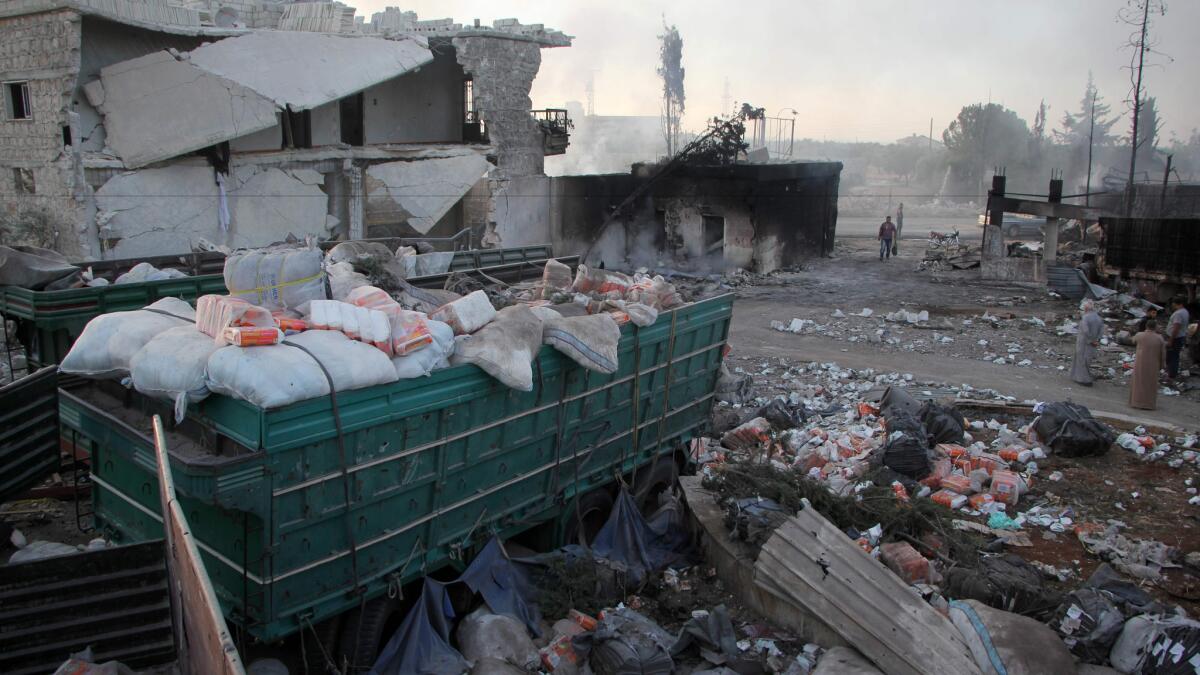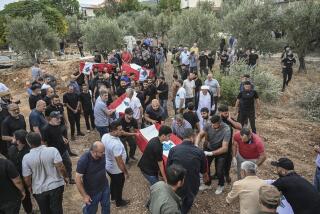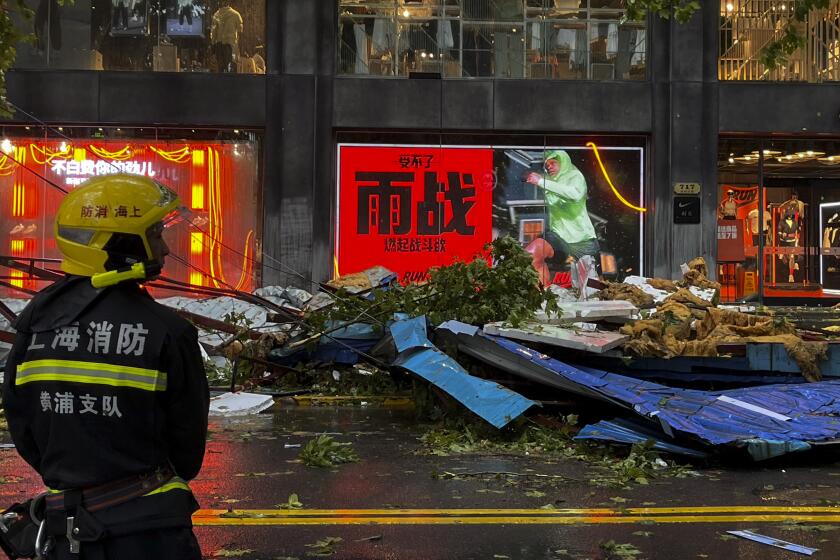‘A massacre is inevitable’: Punishing siege drags on for two Shiite villages in Syria

Reporting from Beirut — Ammar Hammood was shopping at the market when he got word that his 9-year-old son, Haidar, had been shot by a sniper while playing near his house in the northwestern Syrian town of Fuah.
Hammood pushed his way out of the market, so panicked he could barely see. “When I got to the hospital, I found his mother there crying and screaming,” he said.
The bullet had entered below Haidar’s left armpit, furrowing a wound in his stomach, liver and intestines. It broke a rib as it exited from the other side.
After hours of surgery, doctors said the boy would survive. He was luckier than many of the more than 80 people — 15 of them children — killed or wounded by rebel snipers over the last six months in the besieged villages of Fuah and nearby Kefraya.
Dozens of towns have been all but destroyed in the 5 1/2-year conflict over Syria’s future, but this has been a different kind of suffering. A punishing siege imposed by Islamist rebels has cut off these two sister towns in northwest Syria for the last 18 months, leaving them at the mercy of truck bombs, mortar barrages, and the terrifying staccato of sniper fire.
The two towns lie in Idlib province, a predominantly Sunni Muslim region southwest of Aleppo. In March 2015, the entire province was overrun by a powerful jihadist coalition known as the Army of Conquest.
The exception was Fuah and Kefraya, two Shiite villages whose roughly 17,000 residents have remained, even under a devastating blockade, loyal to the government. For most, there has seemed to be little choice: Shiite Muslims are seen as apostates by Islamist hard-liners, and the Army of Conquest has threatened to wipe them out.
Sniping can happen around the clock, 24 hours a day, and it’s happening daily.
— Mohammad Hassan Taqi, head of the townsâ crisis committee
“A massacre is inevitable — maybe not for everyone, but certainly for the young men. They are always sending them threats on walkie-talkies,” said Mohammad Hassan Taqi, head of the towns’ crisis committee.
“But all the possibilities are there: killing, rape, imprisonment of some, to be used as bargaining chips with the government,” he said.
The plight of these two Shiite towns says much about how Syria’s sectarian mosaic has been fractured since the onset of the war. In a country where Shiite and Sunni villages were once spread across the landscape in relative harmony, more and more Syrians are being uprooted into sectarian blocs, their borders becoming new fault lines in the greater Sunni-Shiite conflict.
A key to the fate of Fuah and Kefraya — and one of the only things keeping the towns intact — is the Four Towns Agreement, a complex truce forged in September 2015 linking the fate of the two Shiite communities in Idlib province to that of Zabadani and Madaya, a pair of Sunni towns controlled by Syrian rebels near the capital, Damascus. Those towns have also been subjected to a relentless siege, in this case by pro-government forces, that has left residents on the verge of starvation.
The deal calls for a tit-for-tat arrangement: Any assistance entering or people evacuated from one pair of towns must be matched in equal measure by help to the other pair.
The agreement was brokered by some of the powerful outside forces engaged in the Syrian conflict: Turkey, a predominantly Sunni nation advocating for the Army of Conquest, and Shiite Iran, which helped the Syrian government work its priorities into the deal.
Shiite residents in Fuah and Kefraya have always been minorities in a country dominated by Sunnis, but religion never divided them from their neighbors in the past, said Mayada Aswad, an activist from Latakia whose parents still live in Fuah.
“Students went to the same schools, people would open businesses with each other. … It was all normal,” said Aswad. “There were family visits and, yes, intermarriage.”
Now, residents say most of the violence targeted at them comes from the direction of Binnish and Maraat Misrin, two Sunni-majority communities less than two miles away.
The Sunni villages have the advantage of higher terrain, granting rebel snipers a commanding view against which barricades can offer little protection.
“Sniping can happen around the clock, 24 hours a day, and it’s happening daily,” said Taqi, of the crisis committee.
Taqi was one of more than a dozen current and recent residents of Fuah reached by telephone or through social media. The Times also reviewed a crisis committee report that details the increasingly dire situation created by the lengthy blockade.
The continuing threat of sniper fire has altered the way the townsfolk go about their lives, forcing them to navigate alleyways, or cut passageways in the walls of buildings or trenches on the sides of roads.
A third of all homes in the two towns are uninhabitable, and half the schools are out of commission, according to the report, delivered to government authorities this month.
The main market in the village center is safe, but “it has nothing but frustration,” said one resident, a woman who did not give her name for fear of reprisals.
The siege, coupled with “war merchants and thieves” ready to take advantage of the situation, has made most items too expensive even when they are available, she said. “I’m better off than most, and I’m not able to provide vegetables and milk for my daughter all the time.”
The market now often features spoiled food because there isn’t any other option, residents say.
The United Nations has been unable to deliver aid to the area since April 30, in part because of fighting in the vicinity, but also because the Four Towns Agreement requires assistance to enter the four towns at the same time — a standard that has been difficult to achieve.
In August, Jan Egeland, an advisor to the U.N. special envoy for Syria, said residents were “in a seeming free-fall.”
Fuah and Kefraya do receive some supplies via government air drops, but food, fuel and medicine are still scarce.
“All pharmacies have closed in the market, and the planes only provide the most essential medicines,” said Iyad Baghdadi, a pharmacist living in Kefraya.
The planes come sporadically, he said, “and many times air supplies don’t land intact. The other day, they dropped 36 barrels of fuel. Only two were usable.”
The long siege has torn families apart.
The woman who complained about prices in the market said her husband had fled to Germany after being kidnapped in 2012. She and her daughter had hoped to join him, but a month later, the rebels blitzed through nearby Idlib city and she was trapped.
“We had high hopes in the [Syrian] army and lied to ourselves that it wouldn’t last long … but now my daughter hasn’t seen her father for two years,” she said. “She thinks he’s dead and doesn’t believe it’s him when he speaks to her on the phone.”
The last time Aswad, the activist in Latakia, saw her parents was in 2013. Although her mother is ill, she has not been able to bring her out.
There is also mounting pressure among Sunni opposition forces to break the Four Towns Agreement and wage an all-out offensive against Fuah and Kefraya.
“You want to liberate Syria? Go to the … Shiite colonies in the heart of Sunni areas,” shouted Faisal al-Qassem, an opposition supporter and host of a talk show on the Qatari news channel Al Jazeera. “Kefraya and Fuah, they’re sitting right there in the middle of you. Why don’t you go and forcibly expel them like [the government] did to you? Why don’t you go there and [annihilate] them?”
“The only reason we’ve left those criminals alone is because they’re less important to us than the shoe of a child in Madhya and Zabadani,” replied one guest, Abdul Monem Zain al-Din, an Islamist scholar who describes himself as a general coordinator of the opposition factions.
Residents of the besieged towns, in any case, see little hope that things will ever be as they were.
“The truth is Fuah will be erased from the Earth,” said Abbass Zaid al-Din, an accountant in Fuah. “It will remain only as a memory of those residents who left it years ago.”
Bulos is a special correspondent. Follow @nabihbulos on Twitter.
ALSO
Efforts to shore up the Syrian cease-fire have faltered on all fronts
U.N. suspends aid deliveries to Syria after deadly attack on humanitarian convoy
Kerry lashes out at Russia, calls for grounding of all aircraft over humanitarian routes in Syria
More to Read
Sign up for Essential California
The most important California stories and recommendations in your inbox every morning.
You may occasionally receive promotional content from the Los Angeles Times.










